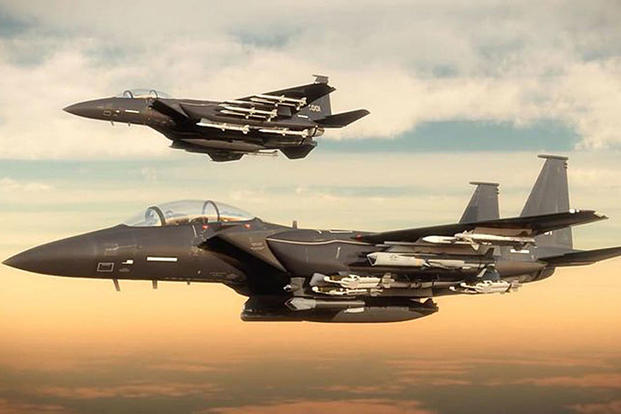Why didn't the Defense Department propose adding an upgraded F-16 Fighting Falcon into its inventory instead the F-15EX fourth-gen plus aircraft it is currently pursuing?
To keep the industrial diversity, according to a senior defense official.
In order to keep a "robust industrial base" and "to have multiple providers in the tactical aircraft portfolio," officials with the Cost Assessment and Program Evaluation office arrived at the Boeing Co-made F-15EX decision because the aircraft provided "a higher-capacity" combination alongside Lockheed Martin's F-35 Joint Strike Fighter, a senior defense official told reporters at the Pentagon on Friday.
An F-16 jet would mean another Lockheed fighter, and the DoD wants to maintain a balance between the two largest defense companies. (That said, the U.S. Navy is still buying F/A-18 Super Hornets, made by Boeing).
"One of the considerations was the diversity of the industrial base," the senior defense official said. "Maintaining a diverse industrial base is in the best interest of the Department of Defense. The more diversity, the more competition ... and the better prices we have."
Then-Secretary of Defense Jim Mattis directed the Pentagon to seek out a mix of stand-in versus stand-off tactical aircraft, the official said. The aircraft that would first penetrate defenses would be an F-35 Joint Strike Fighter -- a stand-in aircraft -- followed by a platform like the F-15EX -- a stand-off fighter -- which would team up to take out targets once the airspace becomes clear.
Mattis, however, did not decide on the specific aircraft model, the official clarified.
The official's comments come shortly after the Defense Department Inspector General launched an investigation into Acting Defense Secretary Patrick Shanahan over his past ties to Boeing, where he worked for 30 years. As deputy defense secretary, Shanahan joined other top leaders to promote the F-15X fourth-generation fighter proposal, Bloomberg said in December.
The official on Friday stressed that Shanahan has not been involved in any discussions pertaining to the F-15EX future procurement.
"This was CAPE bringing it to the forefront," the official said.
Related content:
- How Many Fighter Jets Does the Air Force Need?
- Air Force Wants F-35 Support Costs at F-16 Prices: Goldfein
- New or Used: The Air Force's Two Tricky Paths to 386 Operational Squadrons
As older fourth-gen models such as the F-15C/D Eagle continue to deteriorate, officials looked for a follow-on aircraft that offered affordability and capability.
"We also simply need a certain quantity of platforms with which to deliver ordnance -- we can do those other missions with fourth-gen planes more affordably," the senior defense official said.
The official said the Defense Department wasn't particularly interested in buying additional F-35s this year because of life cycle costs that include operations and sustainment.
"Fifth-gen platforms are more expensive than fourth-gen platforms, so from a capacity standpoint, we can simply buy more capacity with a mix of planes that appropriately match the mission set," the official said.
The F-35's total cost has been projected at more than $1 trillion over a 50-year service lifetime.
An F-35 would also be too expensive for the homeland alert mission that the Air National Guard's F-15C/D fleet currently owns.
The cost of the Air Force's F-35A has dropped to $89 million per aircraft, according to the Joint Program Office.
The Pentagon's Cost Assessment and Program Evaluation office, known as CAPE, estimates the price per F-15EX jet would average about $90 million.
In its fiscal 2020 request, the Air Force seeks to fund eight brand-new jets at a cost of $1.05 billion. Air Force officials on March 12 during the budget request rollout said that cost could rise from the original $80 million projected estimate when accounting for non-recurring engineering costs in the first year of procurement.
The budget decisions speak to the "aviation road map" of the Air Force and thinking on just how many fighter aircraft the service needs to sustain the future fight into 2030 and beyond, the official said.
The Pentagon wants to buy 144 F-15EX planes over the next decade.
-- Oriana Pawlyk can be reached at oriana.pawlyk@military.com. Follow her on Twitter at @oriana0214.












